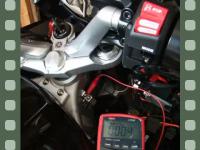I always keep it overnight on a trickle charger (battery tender) but today I wanted to go to ride but no go. I believe the battery is at least 4 years old (its how long I had the bike) but it could be original, just don't know if it has ever been replaced. Besides a no start, what other symptoms are there with a dead battery? I re-attached the battery tender, but it glows red meaning it won't charge the battery. I tried another battery tender but it shows 25% battery strength after about an hour. I've ordered another battery which will be ready on Monday.
Initially my no start was: I would put the key into the ON position but the gauges would not move (display was blank other than a flashing red key symbol) then hit the start button, and nothing. After keeping the other trickle charger on for about an hour and getting 25% battery life the gauges would move and when hit start engine button I heard a fast clicking sound but no start. Hence my thought is that the battery is dead and not accepting a charge.
Initially my no start was: I would put the key into the ON position but the gauges would not move (display was blank other than a flashing red key symbol) then hit the start button, and nothing. After keeping the other trickle charger on for about an hour and getting 25% battery life the gauges would move and when hit start engine button I heard a fast clicking sound but no start. Hence my thought is that the battery is dead and not accepting a charge.
























